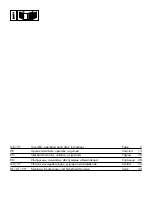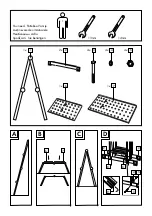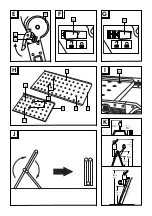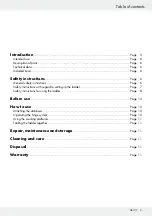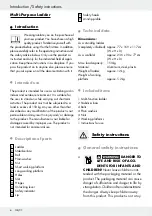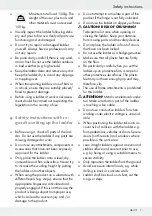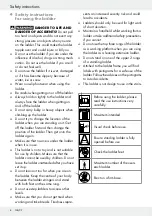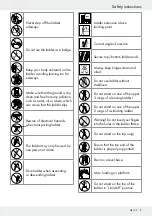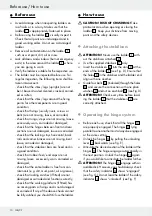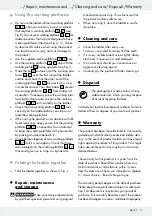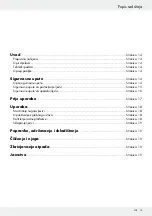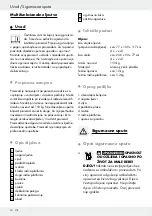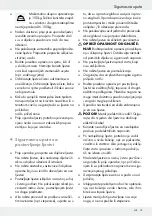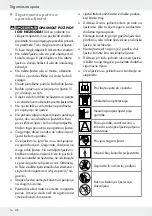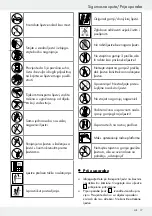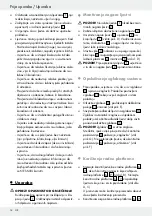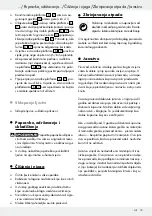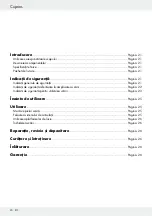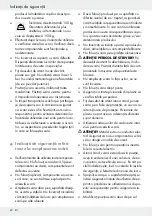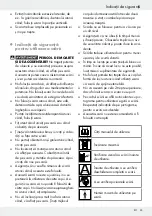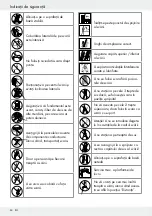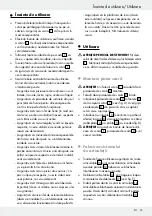
10 GB/CY
Before use / How to use
Q
Before use
J
Avoid damage when transporting ladders on
roof racks or in a lorry. Make sure that the
ladder
1
is appropriately fastened in place.
J
Before using the ladder
1
, visually inspect it.
Check that all parts are undamaged and in
good working order. Do not use a damaged
ladder.
J
Remove all contamination on the ladder
1
,
such as wet paint, dirt, oil or snow.
J
Lock all doors and windows (but not emergency
exits) in the area around the ladder
1
where
you are going to work.
J
Verify the ladder is suitable for the respective use.
J
The ladder must be inspected before use. For
regular inspection, the following items shall be
taken into account:
- check that the stiles / legs (uprights) are not
bent, bowed,twisted, dented, cracked, corrod-
ed or rotten;
- check that the stiles / legs around the fixing
points for other components are in good
condition;
- check that fixings (usually rivets, screws or
bolts) are not missing, loose, or corroded;
- check that rungs / steps are not missing, loose,
excessively worn, corroded or damaged;
- check that the hinges between front and rear
sections are not damaged, loose or corroded;
- check that the locking stays horizontal, back
rails and corner braces are not missing, bent,
loose, corroded or damaged;
- check that the stabilizer bars are fixed and in
a good condition.
- check that rubber feet / end caps are not
missing, loose, excessively worn, corroded or
damaged;
- check that the entire ladder is free from con-
taminants (e.g. dirt, mud, paint, oil or grease);
- check that locking catches (if fitted) are not
damaged or corroded and function correctly;
- check that the working platform (if fitted) has
no missing parts or fixings and is not damaged
or corroded. If any of the above checks cannot
be fully satisfied, you should NOT use the ladder.
Q
How to use
CAUTION! RISK OF CRUSHING!
Take
particular care when opening or closing the
ladder
1
. Keep your distance from moving
parts and the safety devices.
Q
Attaching the stabilisers
ATTENTION!
Never use the ladder
1
with-
out the stabilisers attached
2
.
J
Use the supplied stabilisers
2
only.
J
Insert the stabilisers
2
into the slots
9
at the
ends of the ladder
1
(see Fig. D). Ensure that
the holes
8
in the stabiliser and the ladder end
align with one another.
J
Guide four bolts
3
(included) through the holes
8
and secure the connection with one plain
washers
4
and nut on each bolt
5
(see Fig. D).
ATTENTION!
Check every time before load-
ing the ladder
1
that the stabilisers
2
are
correctly attached.
Q
Operating the hinge system
J
Before each use, check that all the hinges
10
are properly engaged. The hinges
10
lying
parallel to one another must always be engaged
at the same setting.
J
Unlock the hinges
10
by pulling the unlocking
lever
11
backwards (see Fig. E).
J
Articulate the desired section of the ladder at the
hinges
10
. The hinges engage automatically in
the next position. Unlock the hinges
10
again
if you would like to articulate the ladder further.
ATTENTION!
The hinges
10
engage with an
audible click. However, you should always check
that the safety indicator
12
shows “engaged”
(see Fig. G). Do not load the ladder if the safety
indicator
12
shows “unlocked” (see Fig. F).
Summary of Contents for Profi+ 287991
Page 30: ...30 BG J 150kg 150kg 150kg J J J J J J J J J J J J J J J J J J J...
Page 31: ...31 BG J J J J J J J J J J J J J J J J J J J J 2 J J...
Page 32: ...32 BG 3 2...
Page 33: ...33 BG J 1 J 1 J 1 J 1 J J 1 1 2...
Page 35: ...35 BG J J J J J J 3 3...
Page 36: ...36 GR CY 37 37 37 37 37 37 37 38 39 41 42 42 42 42 43 43 43 43 43...
Page 38: ...38 GR CY J 150kg 150kg 150kg J J J J J J Q J J J J J J J J J J J...
Page 39: ...39 GR CY J J J J J J Q J J J J J J J J J J J J J J...
Page 40: ...40 GR CY J J 2 J J...
Page 41: ...41 GR CY 3 2 Q J 1 J 1 J 1 J 1 J J...
Page 43: ...43 GR CY Q J J Q J Q J J J J J Q 3 3 O 2251 1994...


